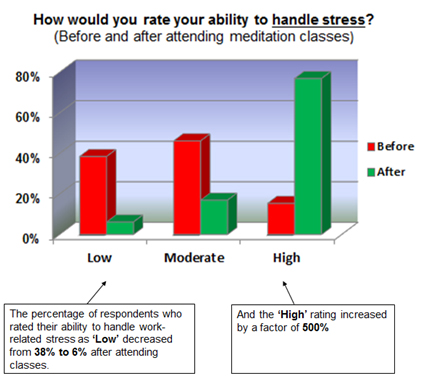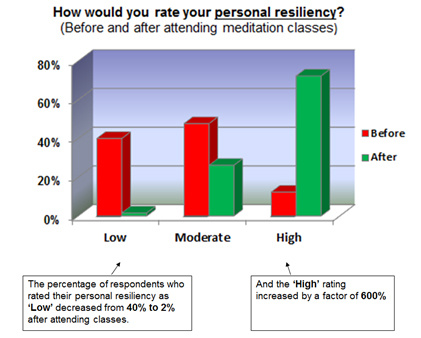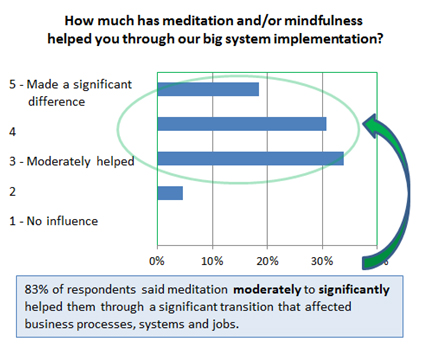Meditation, Mindfulness and Healthy Change Management: A Case Study of Pacific Blue Cross (Part Two)
By Wendy Quan
In this, the second of a two-part series, we explore the quantifiable value of workplace meditation and mindfulness as illustrated by the survey results through Pacific Blue Cross’ large transformation project. Read Part One now.
The Vision: Calm in Challenging Times
With the obvious success of the meditation program prior to the project’s implementation, a very intentional decision was made to see how this practice would specifically help people through the biggest transformation in the company’s history
The vision was to:
- Reduce stress and increase their personal resiliency.
- Focus clearly on people’s self-awareness and reactions through the transition, hoping it would help participants, and have a ripple effect across the organization.
- Benefit the organization by having people calm and committed through the implementation.
Meditation in Action: Key Program Components
The meditation and mindfulness classes are designed for easy attendance and broad appeal to everyone, regardless of experience level. This is a non-religious program, so there is no conflict with anyone’s personal belief system.
Here are the key components of the program:
- Newcomers attend a 30-minute introduction that teaches basic foundation for meditation posture, attitude, and technique.
- Weekly 30 minute class, at lunch time.
- Class starts with a 5-10 minute talk/lesson to settle people in, and instructs on the meditation that is about to begin.
- The meditation is guided for 15-20 minutes, leaving a few minutes at the end of the session for questions and comments.
- Each class teaches a new concept or reinforces a previously taught meditation or mindfulness technique. This allows participants to find what works best for them. The variety also keeps the interest level high.
- Participants must register, but attendance is a drop-in format with no obligation.
- I run this on a volunteer basis.
- A minimum $2 donation per class is collected, which is donated to holistic health and cancer causes.
Although the skills taught and practiced in class apply to both our work and personal lives, I often talk about common work examples that cause stress in the workplace. For example, I refer to the changes that the organization is going through and how it may impact jobs, processes and technologies. Then, I ask the participants to become aware of how they are reacting to such stresses; the simple act of becoming self-aware is an important step to making a decision on how they will choose to react.
Bridging Meditation and Workplace Mindfulness
In the months leading up to the project’s implementation date, the focus of the introductory talk/lesson at the beginning of each class was to specifically address the large transformation from the individual, personal perspective.
This included:
- Becoming very self-aware of one’s own perceptions about the change.
- Learning to mindfully choose their reactions.
- Using mindfulness techniques to become present through their day, and practice non-judgment.
- Recognizing emotions and being mindful of behaviours at work and at home.
- Creating a feeling of community that we are all in this together. We had a change management theme of ‘All Hands on Deck’ for go-live.
- Cultivating calmness and improving clarity of thought and focus through meditation.
I openly and directly addressed many of the rumors and situations that were occurring around the office regarding the project. I discussed these issues and how the use of meditation and mindfulness could help them deal with these. This significantly helped the participants improve their ability to journey through the change.
A Model for Individual Change
I designed my introductory talks at the beginning of the sessions based on Prosci’s ADKAR model for individual change. For example, ‘Awareness’ was discussed as taking the time to become self-aware of how much they understood the change, how they were reacting to the change, and how their reactions affected their emotions and outward behaviors. ‘Desire’ was discussed as reflecting on whether they made a conscious decision to support the change, etc.
Many reported that their perception and mindset regarding the project shifted, and they were better able to manage their own experience, regardless of what was going on around them.
PBC: Perspective, Breathe, Calm
On the day of ‘go-live’, silicone ‘reminder bracelets’ were distributed to all employees, regardless of whether they were meditation class participants. These silicone bracelets had the words ‘Perspective, Breathe, Calm’ imprinted on them. The meditation participants had been involved in selecting the words for the bracelets.
Note that ‘Pacific Blue Cross’ is abbreviated as ‘PBC’, so the meditation participants chose ‘Perspective, Breathe, Calm’. The bracelets were introduced as a way to remind people to be mindful as we went through the implementation. An accompanying card was distributed with the bracelet stating:
- Choose your Perspective
- Remember to Breathe
- Be Calm
The Outcome
The action plan had remarkable results.
The transformation project’s implementation experienced typical challenges, common to any project of this magnitude. We had many technological issues and lots of overtime to keep up with the activity. Employees were very tired.
Staff and management, however, remained calm and committed, and the “All Hands On Deck” approach was apparent.
We created a well-crafted guide for people leaders called Guiding Employees Through ACES. The purpose was to provide guidance and support to people leaders in recognizing distress and employees who are struggling with the change. The guide provided them with suggested ways to handle such situations and how to escalate people issues to Human Resources. We were pleasantly surprised that not one instance occurred where an employee issue needed to be escalated.
There was a surprising calmness throughout the organization during implementation and the calmness continues now. While a number of technology and business process issues were yet to be resolved, the degree of commitment and calmness, remains evident across the organization.
On balance, it is important to note that the implementation was not ‘rosy’ across the entire organization. There were pockets of the company that were hit hard, dealing with huge backlogs, high call volumes, technical and business process issues, and angry customers. The point is that even with such pressures, the blanket of overall calmness allowed people to essentially self-manage through this difficult time.
In the weeks leading up to and after implementation, the attendance was high at the weekly meditation classes. This was very positive, give that people were extremely busy, and missed other health and wellness activities. This confirms the priority people gave to this practice.
The Metrics
There are countless, wonderful anecdotal stories from participants as to how this practice has benefited their lives. Quantifying the measurable benefits, however, is challenging. Despite this, the charts and feedback below are compelling.
The following results are from a survey conducted in September 2014, six months post-implementation:
- 190 registered participants were invited to respond.
- 85 people responded.
- Results below represents 65 people who have attended class at least five times.
Figure 1
Stress

Figure 2
Resiliency

Figure 3
Degree it helped through major transformation

The results show the remarkable and measurable impact that meditation and mindfulness has had on the participants.
In particular, in Figure 3, 83 per cent of the respondents (54 people) said that meditation and mindfulness moderately to significantly helped them through the transition.
The most compelling comment provided by a staff member was:
“This is the single, most important thing the company has done to help people through the project. All other things are good (yoga, gym, etc) but teaching meditation and mindfulness is having the biggest impact.”
Wendy Quan is presenting a MAX session at HRMA’s 2016 Conference + Tradeshow. Her session Improving Organizational resilience: Implementing Workplace Meditation as a Change Management Tool is on Tuesday, April 26. For more information on this and other sessions, please visit hrma.ca/conf2016.
Wendy Quan is a certified change manager who has created an innovative way to build personal and organizational change resiliency through meditation and mindfulness. Her career has also included management in human resources, organizational development, coaching and information technology. She is currently manager of change management with Pacific Blue Cross.








